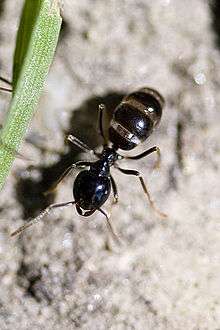Lasius fuliginosus
Lasius fuliginosus, also known as the jet ant or jet black ant, is a species of ant in the subfamily Formicinae. Workers have a black shiny colour and a length of about 4–6 mm, females are larger (6–6.5 mm) and small males reach a length of 4.5–5 mm).[1] The head is heart-shaped.
| Lasius fuliginosus | |
|---|---|
 | |
| Lasius fuliginosus worker | |
| Scientific classification | |
| Kingdom: | |
| Phylum: | |
| Class: | |
| Order: | |
| Family: | |
| Subfamily: | |
| Genus: | |
| Species: | L. fuliginosus |
| Binomial name | |
| Lasius fuliginosus (Latreille, 1798) | |
| Synonyms | |
| |
Distribution
The species has a wide distribution in Europe and Asia, from Portugal and Ireland in the west, Finland in the north to Italy in the south, and eastwards to Korea and Japan.[1][2] In the UK, records suggest that while occasionally found further North before 1970, it is now found mostly south of The Wash, in East Anglia and Southern England, with a few colonies found in Ireland.[3]
Physiology and behavior
To communicate alarm, the species has been known to dispense Dendrolasin (C15H22O), a Terpenoid compound, from their mandibular glands.[4]
The species is closely related to the Nitidulid beetle Amphotis marginata, called the "highwayman" of the local ant world. The beetles occupy shelters along the foraging trails of L. fuliginosis. When night comes, they patrol the trails and take food from the ants returning to the nest. They specifically target those ants with a lot of food in their bodies. They trick ants into regurgitating into their mouths, a common act between ants and other animals called "trophallaxis". The ants soon realize they have been tricked and begin to fight the beetle. The beetle responds by removing itself from the ants' mouths and flattening its body to the ground in a way that ants cannot roll them over and effectively combat them.[4]
Environment
The species builds a "cardboard" nest in old hollow trees, using "board" – a mixture of chewed wood with saliva.[5] A nest contains only one queen, but a large colony can contain as many as 15,000 workers.[6]
Like other black ants they tend populations of aphids for their honeydew, and can often be seen travelling in both directions, following scent-trails for long distances to their source of food, which is often a tree.[5] The trails the species make to forage and transport food commonly last for months. As the workers clear the paths of vegetation and debris, making the path easy for massive amounts of ants to travel efficiently.[4] They rarely carry other insects back to the nest.[5]
Reproduction as a hyperparasite
While other black ants such as Lasius niger, the smaller but much more common (in the UK) species, a queen founds its own nest by laying eggs and then feeding the new larvae with a fluid produced by breaking down its own muscles; a process that leaves her terrible weak as she cannot tend the larvae and forage for food at the same time. A post-nuptial queen of Lasius fuliginosus cannot found her own nests, but establishes a nest through social parasitism in another species of the same genus - Lasius umbratus, a rare yellow ant with an underground habit (unlike the common yellow ant Lasius flavus which makes small mounds in grass and lawns). She kills or ousts the existing queen and lays eggs, which the existing workers tend. Her offspring workers then slowly take over the nest. Lasius umbratis also establishes its nest in a similar way, by taking over the nest of Lasius niger, the common black ant, so Lasius fuliginosus is sometimes referred to as a hyperparasite.[7]
References
- Collingwood, C. A. (1979). "The Formicidae (Hymenoptera) of Fennoscandia and Denmark" (PDF). Fauna Entomologica Scandinavica. 8: 1–174.
- Collingwood, C. A. (1982). "Himalayan ants of the genus Lasius (Hymenoptera: Formicidae)" (PDF). Systematic Entomology. 7 (3): 283–296. doi:10.1111/j.1365-3113.1982.tb00446.x.
- Partridge, John. "The Jet Ant - Lasius fuliginosus". Worcestershire Biological Records Centre. Retrieved 13 October 2016.
- Hölldobler, Bert; Wilson, Edward O. (1990). The Ants. Wilson, Edward O. Cambridge, Mass.: Belknap Press of Harvard University Press. ISBN 0-674-04075-9. OCLC 19325464.
- "Black ant". Buglife. Retrieved 13 October 2016.
- "Black ant". Buglife. Retrieved 13 October 2016.
- "Black ant". Buglife. Retrieved 13 October 2016.
External links
